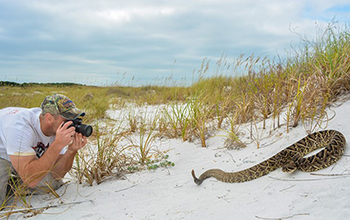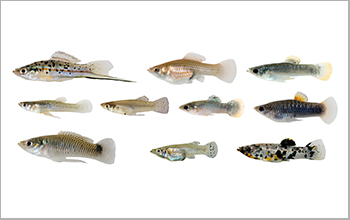搜索结果: 1-13 共查到“生物学 Toxic”相关记录13条 . 查询时间(0.259 秒)
While invasive zebra mussels consume small plant-like organisms called phytoplankton, researchers discovered during a long-term study that zebra mussels can actually increase Microcystis, a type of ph...

Toxic tiger rattlesnake venom advances genetic science techniques(图)
Toxic tiger rattlesnake venom advances genetic science techniques
2021/1/28
The tiger rattlesnake possesses the simplest, yet most toxic, venom of any rattlesnake species. Now new research led by a University of South Florida biologist explains the genetics behind t...

Biologists find 10 lineages of fish able to live in highly toxic streams(图)
Biologists 10 lineages fish able live highly toxic streams
2020/7/10
Using the same mechanism, several species of fish have adapted to harsh environments, calling into question the idea of evolutionary chance, according to a National Science Foundation-funded stud...
Innovative Sensor Can Screen Toxic Drugs,Help Develop Biomaterials,and Much More
Innovative Sensor Screen Toxic Drugs Help Develop Biomaterials Much More
2017/4/27
Researchers at the University of California, Riverside have found an innovative new use for a simple piece of glass tubing: weighing things. Their glass tube sensor will help speed up chemical toxicit...
The 10th International Conference on Toxic Cyanobacteria
Cyanobacterial detection Cyanotoxin analysis
2016/7/29
On behalf of the Local Organizing Committee, I cordially invite you to attend the 10th International
Conference on Toxic Cyanobacteria to be held in Wuhan, China from 23 to 28 October, 2016.
Genetics help fish thrive in toxic environments,collaborative study finds
Genetics fish thrive toxic environments collaborative study
2016/2/23
They live in caves and springs throughout Mexico and thrive in water so toxic that most forms of life die within minutes.Meet the Atlantic molly – an extremophile fish that lives in toxic water full o...
Researchers at the University of California, Riverside have found parts produced by some commercial 3D printers are toxic to certain fish embryos. Their results have raised questions about how to disp...
Engineering a protein to prevent brain damage from toxic agents
Engineering a protein prevent brain damage toxic agents
2014/8/14
Research at New York University is paving the way for a breakthrough that may prevent brain damage in civilians and military troops exposed to poisonous chemicals—particularly those in pesticides and ...
Acute Toxic Effects of Malathion on the 21st Stage Larvae of the Marsh Frog
Acute toxicity test malathion organophosphorus insecticide Amphibia anuran larvae marsh frog Rana ridibunda
2010/3/25
Currently, amphibian decline is accepted as a global problem. One of the most important proposed causes for the decline is the use of agrochemicals, especially pesticides. Nevertheless, information ab...
Gypsophila sphaerocephala Fenzl ex Tchihat.: A Boron Hyperaccumulator Plant Species That May Phytoremediate Soils with Toxic B Levels
Boron mine Elymus ICP-AES phytoremediation Puccinellia tolerance
2010/3/19
Analyses were carried out to identify boron (B) hyperaccumulating plant species in an actively B- mined area of Kırka, Eskişehir, Turkey. Only 4 plant species, Gypsophila sphaerocephala Fenz...
The Toxic Effects of Malathion (Organophosphate Insecticide) on the Daphnia magna Straus, 1820 (Crustacea, Cladocera)
Crustacea Cladocera Daphnia magna malathion toxicity
2010/3/30
The toxic effects of technical grade (95 %) malathion and commercial (25 %) malathion were investigated on young (£ 24 h old) Daphnia magna in static acute toxicity tests (24 and 48 h). The cult...
The Effects of Toxic Aluminium and Low pH on Gill Development of Rainbow Trout ( Oncorhynchus mykiss, Walbaum) Larvae.
Oncorhynchus mykiss rainbow trout pH aluminium gill development
2010/4/1
In this study, the gill development of rainbow trout ( Oncorhynchus mykiss Walbaum) larvae exposed to toxic aluminium (200 ?g/L), those exposed low pH (4.5) alone and those exposed to both for 30 days...


